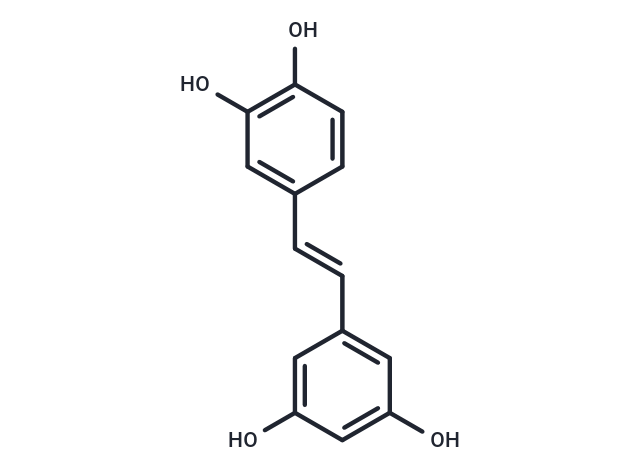Shopping Cart
Remove All Your shopping cart is currently empty
Your shopping cart is currently empty
Piceatannol (Astringenin) is an anti-inflammatory, immunomodulatory and antiproliferative agent. It inhibits p56lck and syk protein tyrosine kinases and inhibits NF-κB activation and gene expression of TNF-induced. It is synthetic from the conversion of resveratrol by cytochrome P450 1B1.

| Pack Size | Price | USA Warehouse | Global Warehouse | Quantity |
|---|---|---|---|---|
| 5 mg | $35 | In Stock | In Stock | |
| 10 mg | $55 | In Stock | In Stock | |
| 25 mg | $105 | In Stock | In Stock | |
| 50 mg | $153 | In Stock | In Stock | |
| 100 mg | $217 | In Stock | In Stock | |
| 1 mL x 10 mM (in DMSO) | $46 | In Stock | In Stock |
| Description | Piceatannol (Astringenin) is an anti-inflammatory, immunomodulatory and antiproliferative agent. It inhibits p56lck and syk protein tyrosine kinases and inhibits NF-κB activation and gene expression of TNF-induced. It is synthetic from the conversion of resveratrol by cytochrome P450 1B1. |
| Targets&IC50 | MLCK:12 μM, CAK:3 μM, PKC:8 μM |
| In vitro | In mast cells, Piceatannol is an effective inhibitor of histamine release, selectively suppressing Syk to block receptor-mediated cellular responses, including inhibition of 1,4,5-IP3 secretion, synthesis, membrane ruffling, and transportation. Piceatannol inhibits Syk activity approximately tenfold more potently than Lyn. When RBL-2H3 cells are treated with Piceatannol, antigen-stimulated phosphorylation of Syk and most other cellular proteins is strongly inhibited. However, it doesn’t affect the phosphorylation of receptor gamma or beta subtypes, presenting a dose-dependent inhibition. Piceatannol also effectively inhibits CDPK, MLCK, PKC, and PKA, with IC50 values of 19 μM, 12 μM, 8 μM, and 3 μM respectively. It selectively inhibits IFNα-induced tyrosine phosphorylation of STAT3/5 without affecting STAT1/2 and selectively inhibits the dephosphorylation of tyrosine on Jak1 and IFNAR1, not affecting Tyk2 and IFNAR2. Piceatannol induces apoptosis in BJAB Burkitt-like lymphoma cells via the activation of caspase-3 and changes in mitochondrial permeability, with an ED50 of 25 μM, independent of the CD95/Fas signaling pathway. It inhibits NF-κB activation induced by TNF, H2O2, PMA, lipopolysaccharides, okadaic acid, and ceramide. Specifically, it inhibits TNF-induced expression of NF-κB-dependent reporter genes (matrix metalloproteinase-9, cyclooxygenase-2, and cyclin D1) by blocking TNF-induced IκBαof phosphorylation, p65 nuclear translocation, and IκB kinase activation, independent of tyrosine kinase. Piceatannol binds to intracellular phosphatidylinositol kinase in an ATP-competitive manner, inhibiting its activity and exhibiting anti-atherosclerotic effects superior to resveratrol. Lastly, Piceatannol suppresses the proliferation of both androgen-dependent and -independent CaP cells and notably reduces the expression of mTOR and its key effectors AKT and eIF4EBP-1. |
| In vivo | Oral administration of Piceatannol significantly ameliorates structural damage to the colon in BALB/c mice with dextran sulfate sodium-induced colitis, markedly reducing the production of inflammatory mediators (such as nitric oxide, prostaglandin E2, and pro-inflammatory cytokines), and notably diminishes colonic myeloperoxidase (MPO) activity. In type 2 diabetic db/db mouse models, Piceatannol suppresses early elevation of blood glucose levels and improves impaired glucose tolerance in later stages. |
| Kinase Assay | In Vitro Protein-tyrosine Kinase Assays: Recombinant Syk is expressed in baculovirus-infected St9 cells. Assays of recombinant Syk activity are carried out using angiotensin I peptide as substrate. The enzyme activities of recombinant Syk are measured by phosphorylation of angiotensin I peptide in the presence of various concentrations of Piceatannol. |
| Cell Research | Cells are exposed to increasing concentrations of Piceatannol. For the determination of cell proliferation, cells are assayed at 72 hours by trypan blue exclusion using a hemocytometer. After 1 week, colonies are stained with 1.25% crystal violet and quantified by measuring the absorbance at 595 nm. (Only for Reference) |
| Synonyms | trans-Piceatannol, Astringenin |
| Molecular Weight | 244.24 |
| Formula | C14H12O4 |
| Cas No. | 10083-24-6 |
| Smiles | C(=C/C1=CC(O)=CC(O)=C1)\C2=CC(O)=C(O)C=C2 |
| Relative Density. | 1.1245 g/cm3 (Estimated) |
| Storage | Powder: -20°C for 3 years | In solvent: -80°C for 1 year | Shipping with blue ice/Shipping at ambient temperature. | ||||||||||||||||||||||||||||||
| Solubility Information | Ethanol: 24.4 mg/mL (99.9 mM), Sonication is recommended. DMSO: 14.14 mg/mL (57.89 mM), Sonication is recommended. | ||||||||||||||||||||||||||||||
| In Vivo Formulation | 10% DMSO+40% PEG300+5% Tween 80+45% Saline: 4 mg/mL (16.38 mM), Sonication is recommended. Please add the solvents sequentially, clarifying the solution as much as possible before adding the next one. Dissolve by heating and/or sonication if necessary. Working solution is recommended to be prepared and used immediately. The formulation provided above is for reference purposes only. In vivo formulations may vary and should be modified based on specific experimental conditions. | ||||||||||||||||||||||||||||||
Solution Preparation Table | |||||||||||||||||||||||||||||||
DMSO/Ethanol
| |||||||||||||||||||||||||||||||
| Size | Quantity | Unit Price | Amount | Operation |
|---|

Copyright © 2015-2025 TargetMol Chemicals Inc. All Rights Reserved.